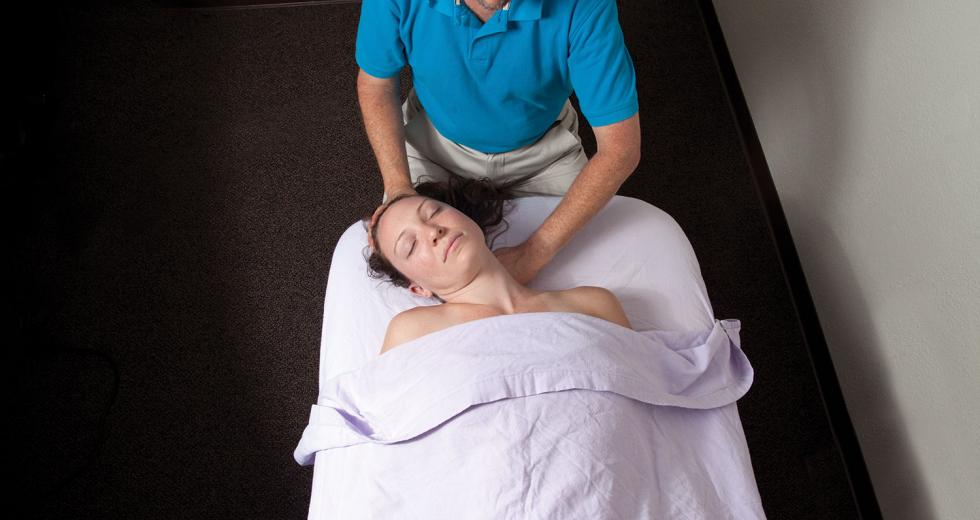Tony Mickela doesn’t consider his weekly massage an act of decadent pampering. The 67-year-old retired Sacramento educator instead views the therapy, which he has been receiving for the past 10 years, as an integral part of a healthy lifestyle and his effort to keep an array of health problems at bay.
Mickela says massage not only helps his muscle aches and chronic back and neck pain, but it relaxes him and improves his range of mobility. It also keeps his diabetes, blood pressure and cholesterol in check following a six-way heart bypass surgery in 2001.
“The thing that’s most impressive to me is my heart rate,”
Mickela says. “It used to average over 100 (beats per minute),
and now it’s at 60 to 65.”
These are important numbers to Mickela; his father and
grandfather died of heart attacks, and his mother has suffered
four.
He credits his longtime massage therapist, Kathleen Bailey, for his health improvements. Healing has come, he says, not only from her healing hands but from her recommendations on other treatments, including herbal and natural medicines and actively pursuing a more positive outlook on life.
“She’s taught me to have a new attitude by talking to me and giving me tools to deal with stress and things that come up,” Mickela says. “It’s hard to quantify how much my life has improved; I can’t do that. But I feel like, mentally, she’s had a very positive influence.”
Mickela is part of a growing number of practitioners and clients nationwide who swear massage therapy provides direct health benefits beyond relaxation. While many still view massage as a luxurious indulgence for the well-heeled, a growing body of research supports assertions of tangible health benefits, and more patients are incorporating massage into their overall health management programs.
Recent studies show that massage boosts immune function in women with breast cancer, reduces symptoms of asthma in children, helps muscle function for carpel tunnel patients and increases weight gain in premature infants.
Those are some of the physiological benefits being studied by various medical and health groups. The Touch Research Institute at the University of Miami has conducted more than 100 studies on the positive effects of massage therapy on many functions and medical conditions in a range of age groups, director Tiffany Field says.
Among the more significant research findings are enhanced growth in preterm infants, diminished pain in fibromyalgia patients, increased pulmonary function in asthma patients, decreased glucose levels in diabetics, improved immunity for HIV and cancer patients and improved alertness and performance in general.
Field says many of the effects are believed to be byproducts of decreased stress hormones. Massage is being used to calm cancer patients and for people who suffer from anorexia, depression, burns, headaches and multiple sclerosis. Massage also is being studied in the treatment of the elderly, veterans, pregnant women and sexual abuse victims.
Swedish massage remains the most requested bodywork in spas nationally, the Associated Bodywork & Massage Professionals (ABMP) reports, and women typically get more massages.
But since the 1980s, massage therapists have shed their image as luxury service providers or as a cover for illicit operations. The face of clients and practitioners is changing and getting more diverse as well, and more than 250 massage modalities are provided in the U.S. today.
Bailey, who is Mickela’s massage therapist, says the economy hasn’t affected her business.
“The economy hit a lot of people hard, but I’ve found that people want to reduce stress as much as possible,” she says. “Many of them have been coming to me for 15 years or longer, and they don’t want to live without it.”
When she started practicing almost 20 years ago, many people linked massage with prostitution, but the industry has gained a more professional image, Bailey says.
James Mally, a Sacramento naturopathic doctor and massage therapist, has been massaging clients and training new therapists for 35 years and has observed the shift from Swedish massage for light relaxation toward massage for tangible health benefits.
“I used to do more relaxation massage, and now I’m doing more therapeutic massage, deep tissue massage and treatment of sports injuries,” Mally says. “I see people coming for regular massage as part of maintaining general health. They’re also coming as part of rehab for injuries, chronic pain or keeping their range of motion.”
An increasing number of clients are coming to him for treatment of a chronic condition or injury, from tendonitis and sciatica, to menstrual cramps and hiccups. He treats patients with muscle strains and cramps, plantar fasciitis, rotator cuff problems, shin splints and tennis elbow.
Some of his clients suffer from an increasingly sedentary lifestyle, including people who sit for long periods as part of their workday. Sitting actually shortens the hip flexors, which can lead to lower back pain, Mally says.
Diedrea Welch, director of the Healing Arts Institute in Citrus Heights, knows firsthand the physiological benefits of massage therapy, even if they are only based in stress reduction.
Seven years ago, Welch lost her 8-year-old son to a vehicle accident caused by a drunk driver. Two days after the boy’s death, Welch, her husband and 9-year-old daughter sought healing from a massage therapist recommended to them.
“I’m alive because of her,” Welch says. “Massage isn’t what many people think it is. They imagine luxurious spas with young women working on you and that it’s for wealthy people. But there’s healing on many different levels. Massage allows for healing on a higher level, so we can heal emotionally. Sometimes we need time to sort things out so we can feel joy again.”
After finding relief from the trauma of her son’s death, Welch graduated from the Healing Arts Institute and eventually bought the school.
“We teach our students that healing starts as soon as you meet with a client and smile at them,” she says. “Relaxing can begin by just placing my hand on their shoulder. It all starts from your intention and your heart. We’re bringing another human being into the room and holding space for them to heal.”
The gender ratio of clients and practitioners is evening out, too.
“Many of our students were previously construction workers or farmers,” Welch says. “If you looked at them, you would never think they would be into it. But many of them came for help with pain and decided to go into massage therapy.”
Cost is also declining as a barrier to service, consumers pay an average of about $60 out of pocket for a basic massage, according to the ABMP, while the service can cost up to three times more at exclusive spas.
Welch says the most common benefits from massage are emotional release and stress reduction for muscle relaxation.
“We treat tension and anxiety,” she says. “Even if you don’t know it’s there, it’s in your muscles.”
There’s been a widespread surge in scientific interest in massage therapy. The National Center for Complementary and Alternative Medicine, part of the National Institutes of Health, is currently spending $2.7 million on massage research, up from $1.5 million in 2002. The Massage Therapy Foundation, a nonprofit organization that funds massage research, held its first scientific conference in 2005 and will have its third conference in Boston next year.
The new research provides clues to what happens physiologically after a massage. Theories have abounded about the biological effects for years. One study found that a single 45-minute massage led to a slight reduction in the stress hormone cortisol in the blood, a decrease in cytokine proteins involved with inflammation and allergies, and a boost in white blood cells fighting infection.
The scientific research is running parallel to an uptick in massage therapy’s popularity. About 8.3 percent of American adults received massage in 2007, up from 5 percent in 2002, a National Health Statistics report shows. Massage was expected to be a $10 billion to $11 billion industry in 2011 in the U.S., estimates from the nonprofit American Massage Therapy Association showed.
The science-based evidence also fuels discussion about including massage therapy in insurance plans. Washington is the only state requiring insurers to cover massage therapy, but some private insurers are offering limited coverage for massage or making it available as an add-on purchase. Chiropractors and physical therapists, usually covered by insurance, are beginning to refer patients to massage therapists as part of their treatment.
No statistics are available to support the growth of massage therapy in the greater Sacramento region, but Welch points to a growing number of new massage therapy businesses opening locally, even as the economic recovery drags.
“No one heard of Massage Envy five years ago,” Welch says, referring to the nationwide chain.
Many of the new businesses, however, offer only Swedish-style massage in low-overhead chain franchises.
“We’re trying to raise awareness of different modalities,” Welch says. “People come in for a Swedish massage, and they try other kinds for different goals, such as grief or loss, an injury or chronic pain.”
Therapeutic massage is more than “rubbing it where it hurts,” Mally says. Knowing a body’s anatomy allows a therapist to identify and treat muscles that are overworked and sore from compensating for other muscles.
“Often the muscles that are tight are not the ones that are complaining,” he says. “A good therapist will know that and will know where to work.”
For more information about Mike Graff: www.mikegraff.co
Recommended For You

Juiced
Bowel Formula No. 2, friend or foe?
It’s a seductive pitch: Cleanse your body. Feel healthy. Lose weight.
You only have to do one thing: starve.

Flexible by Definition
Pilates maintains popularity and expands its reach
When Kelly Sassman started giving Pilates instruction at her Sacramento studio 12 years ago, people couldn’t even pronounce the name of the fitness program.




Comments
No statistics are available to support the growth of massage therapy in the greater Sacramento region, but Welch points to a growing number of new massage therapy businesses opening locally, even as the economic recovery drags.
I completely agree with you. Thank you!